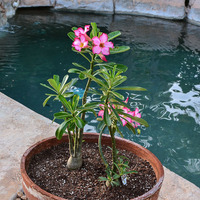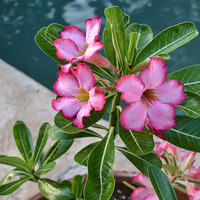Common name: Desert rose
Other common names: Mock azalea
Description
Desert rose is a flowering succulent originating from dry areas of Sub-Saharan Africa and Arabia and is a close relative of Frangipani (Plumeria rubra) and Oleander (Nerium oleander).
It grows slowly to heights of up to 6 m (20 ft) under ideal conditions, though it is more typically 1 to 2 m (3 to 6 ft) tall and has a shrub-like appearance. The stems are soft wooded, and the trunk is swollen at the base, adding to the plant's ornamental appeal.
The leaves are dark green, club-shaped, rounded at the tip and tapered toward the base, attaching directly to the branches. They are few, especially in the dry season when they fall off the plant, leaving the branches mostly bare.
Flowering is at its fullest in the dry season. However, on-and-off flowering is common the rest of the year in regularly watered gardens. The flowers are monoecious, with separate female and male flowers on the same plant. They are showy and, as a result of selective breeding, come in a range of colours from red to pink, yellow, pure white or white with pink margins, depending on the variety or hybrid.
Fruiting is irregular, with no fruiting in some years. When the plant does fruit, they are slender, curved seedpods with small cylindrical, hairy tufted seed inside, designed for wind dispersal.
Use
Desert rose is commonly cultivated as a container or specimen plant for its showy floral display and the unusual, sometimes curious shapes the trunk develops. It is a good performer in seaside gardens because of its tolerance to light salt spray and is a suitable plant for poolsides and Bonsai, doing especially well in a container or pot as this provides the fast drainage it needs.
Climate
Although naturally adapted to dry climates, Desert rose tolerates humidity, growing and flowering reliably in dry to humid subtropical and tropical climates, generally frost-free areas with annual lows of 11 to 25°C, annual highs of 20 to 37°C, annual rainfall of 200 to 2300 mm and a dry season of 10 months or less, extending to 12 months with irrigation.
Growing
New plants are easily grown from seed or cuttings. Seed grown plants start flowering in the second year, a year or two earlier than vegetatively grown plants. It performs best on quick-draining sand and sandy loam soils of a slightly acid to moderately alkaline nature, generally with a pH of 6.5 to 8.0 and on sites with full to partial sun exposure.
Problem features
Desert rose is unlikely to become a weed due to its shy seeding habit. There does not appear to be any record of it anywhere as a serious weed. It is assessed as a low weed risk species for Hawaii by the Hawaii Pacific Weed Risk Assessment (HPWRA) project.
The sap is highly poisonous and has a long history as an arrow poison in its native range.
Where it grows
References
Books
-
Barwick, M., et al. 2004, Tropical & subtropical trees : a worldwide encyclopaedic guide, Thames and Hudson, London
-
Perry, F. & Hay, R. 1982, A field guide to tropical and subtropical plants, Van Nostrand Reinhold Company, New York
-
Polunin, Ivan 1987, Plants and flowers of Singapore, Times Editions, Singapore
-
Randall, R. P. 2007, The introduced flora of Australia and its weed status, Cooperative Research Centre for Australian Weed Management, Glen Osmond, South Australia
-
Rauch, F. D. & Weissich, P. R. 2000, Plants for tropical landscapes : a gardener's guide, University of Hawaii Press, Honolulu
-
Schmelzer G.H., et al. 2008, Plant Resources of Tropical Africa, Volume 11(1) : Medicinal Plants 1, PROTA Foundation, Backhuys Publishers, Leiden



